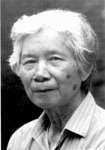Copyright © 1986-2016, Witness Collection and other copyright holders. All rights reserved.
Images and content on this site may not be reproduced in any form without prior written consent from Witness Collection.
For information about exhibitions, loans, internships or other forms of collaboration, please email us via the contact us page.

Nghiêm was quick to join the resistance movement and moved to the Việt Bắc (Northern Vietnam) where he ran a painting studio for the provisional government’s Association of Arts and Literature. In 1950, the Resistance School of Fine Arts was inaugurated under director Tô Ngọc Vân in the Việt Bắc, based in the commune of Yến Dã within the district of Đại Từ, Thái Nguyên province. Nghiêm served as a teacher, alongside other artists who would later also become highly acclaimed, such as Trần Văn Cẩn, Nguyễn Sỹ Ngọc and Nguyễn Văn Tỵ. After the defeat of the French in 1954, Nghiêm returned to Hanoi and taught at the predecessor of the Industrial Fine Arts College until 1960, after which he became more secluded and worked as an independent artist.
Nghiêm’s highly innovative style is characterised by a deceptive modernist simplicity, while his inspirations delve deep into Vietnamese traditions, whether the Vietnamese zodiac, traditional folk dance, ancient mythology or local festivals. His art was the first to build on primitive elements deriving from the most traditional Vietnamese artistic imagery – from the sculptures of ancient village pagodas and communal houses to the icons of Đông Sơn culture and characters of literary masterpieces, such as the Tales of Kiều.
Nghiêm is often described as the most Vietnamese of Vietnam’s artists and his work has had a profound influence on the later generation, especially those who came to prominence as Vietnam opened up to the outside world from the 1990s onwards.
† While public documents describe Nghiêm as born in 1922, the artist himself has stated that he was actually born in 1919.
Nguyễn Tư Nghiêm
